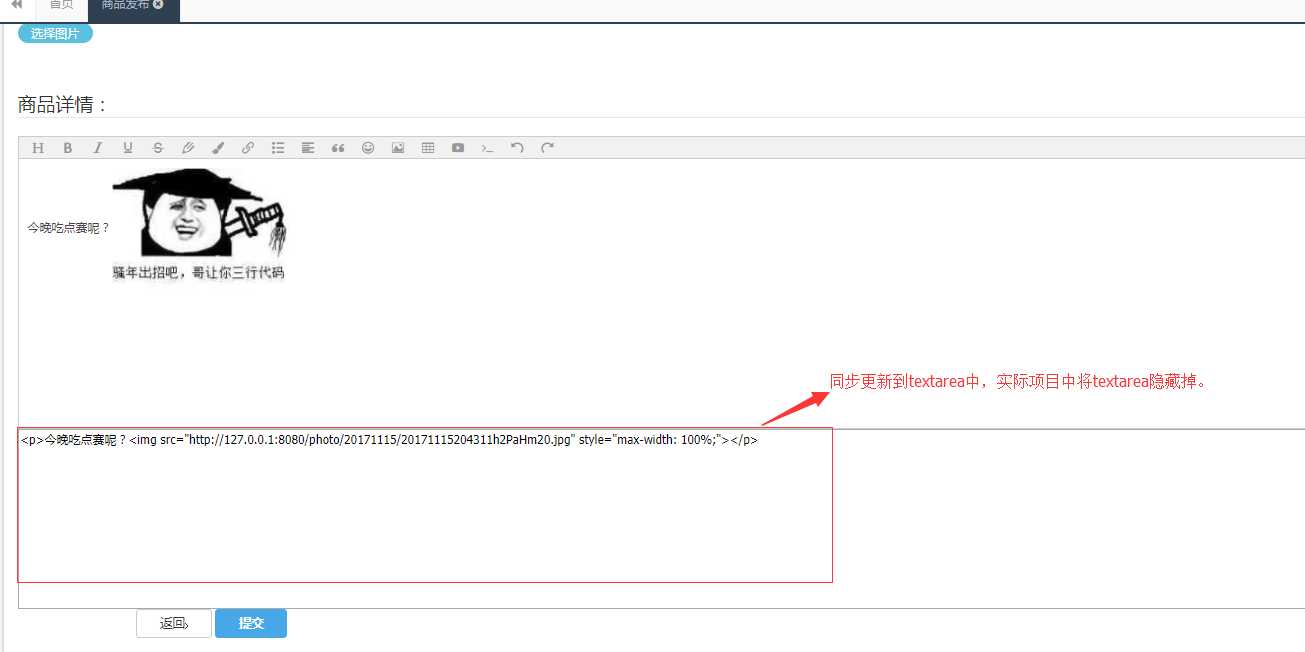标签:flash插件 hooks esc 不能 原理 conf 字符 change display
最近项目需要我做些前端的事,这让我这个半吊子前端很是痛苦。项目中需要一个编辑器,之前找了个ueditor,插件比较多,需要改源码等等不说,最后弄好了,发现需要flash插件。没办法,只有推到重来,在网上寻找对比后,最后决定使用用wangEditor,首先它简单,轻量,基本能满足我的需求,不好的地方就是网上的demo不是很多,不是大公司的开源产品,不知道能不能坚持更新下去,不过ueditor都不更新了,也没必要强求。
首先贴上官方地址:https://www.kancloud.cn/wangfupeng/wangeditor3/335771。
没什么说的,就是简洁,轻量、官网上的例子已经写很详细了,主要记录下我的做法。
<div id="div1"> </div> <textarea name="ueditorContent" id="ueditorContent" style="width:100%; height:200px;display:none" ></textarea> <script type="text/javascript"> var E = window.wangEditor; var editor = new E(‘#div1‘); var $ueditorContent = $(‘#ueditorContent‘); editor.customConfig.onchange = function (html) { // 监控变化,同步更新到 textarea $ueditorContent.val(html); }; editor.customConfig.uploadImgServer = ‘/bhym/systemController/fileUp.do‘ ; // 上传图片到服务器, // 隐藏“网络图片”tab // editor.customConfig.showLinkImg = false; editor.customConfig.uploadImgHooks = { // (但是,服务器端返回的必须是一个 JSON 格式字符串!!!否则会报错) customInsert: function (insertImg, result, editor) { // insertImg 是插入图片的函数,editor 是编辑器对象,result 是服务器端返回的结果: var url = result.obj; insertImg(url); }, }, editor.create(); // 初始化 textarea 的值,向后台提交textarea中的值 $ueditorContent.val(editor.txt.html()) </script>
因为前端参数比较多,不想单独去写个ajax请求去发送请求。所以为了偷下懒,就在编辑器的下方,定义了一个textarea ,将它隐藏掉,将编辑器的内容同步更新到textarea中。再通过将textarea中的内容用提交form
表单的方式提交。前端就这样了,再来看看后台的图片处理,思路是:按照常规的文件上传方式将图片上传到服务器,返回一个url(虚拟路径)再通过配置虚拟路径的方式访问图片,前面有篇文章说的怎么配置虚拟路径:http://www.cnblogs.com/magic101/p/7756402.html。
/** * * @Title: fileUp * @Description:wangEditor上传图片 * @param * @return */ @RequestMapping("/fileUp") @ResponseBody public AjaxJson fileUp(HttpServletRequest request) { AjaxJson j = new AjaxJson(); MultipartHttpServletRequest multipartRequest = (MultipartHttpServletRequest) request; try { multipartRequest.setCharacterEncoding("UTF-8"); Map<String, MultipartFile> fileMap = multipartRequest.getFileMap(); // 文件数据库保存的路径 String path = null; // 文件保存在硬盘的相对路径 String realPath = null; realPath = ResourceUtil.getConfigByName("webUploadpath") + "/"; path = ResourceUtil.getConfigByName("http_url") + "/"; File file = new File(realPath); if (!file.exists()) { file.mkdirs();// 创建根目录 } realPath += DateUtils.getDataString(DateUtils.yyyyMMdd) + "/"; path += DateUtils.getDataString(DateUtils.yyyyMMdd) + "/"; file = new File(realPath); if (!file.exists()) { file.mkdir();// 创建文件时间子目录 } String fileName = ""; // String swfName = ""; for (Map.Entry<String, MultipartFile> entity : fileMap.entrySet()) { MultipartFile mf = entity.getValue();// 获取上传文件对象 fileName = mf.getOriginalFilename();// 获取文件名 // swfName = // PinyinUtil.getPinYinHeadChar(oConvertUtils.replaceBlank(FileUtils.getFilePrefix(fileName)));// // 取文件名首字母作为SWF文件名 String extend = FileUtils.getExtend(fileName);// 获取文件扩展名 String myfilename = ""; String noextfilename = "";// 不带扩展名 noextfilename = DateUtils.getDataString(DateUtils.yyyymmddhhmmss) + StringUtil.random(8);// 自定义文件名称 myfilename = noextfilename + "." + extend;// 自定义文件名称 String savePath = realPath + myfilename;// 文件保存全路径 File savefile = new File(savePath); if (entity.getKey() != null) { // 设置文件数据库的物理路径 String filePath = path + myfilename; j.setObj(filePath); } // 文件拷贝到指定硬盘目录 if ("txt".equals(extend)) { // 利用utf-8字符集的固定首行隐藏编码原理 // Unicode:FF FE UTF-8:EF BB byte[] allbytes = mf.getBytes(); try { String head1 = toHexString(allbytes[0]); // System.out.println(head1); String head2 = toHexString(allbytes[1]); // System.out.println(head2); if ("ef".equals(head1) && "bb".equals(head2)) { // UTF-8 String contents = new String(mf.getBytes(), "UTF-8"); if (StringUtils.isNotBlank(contents)) { OutputStream out = new FileOutputStream(savePath); out.write(contents.getBytes()); out.close(); } } else { // GBK String contents = new String(mf.getBytes(), "GBK"); OutputStream out = new FileOutputStream(savePath); out.write(contents.getBytes()); out.close(); } } catch (Exception e) { String contents = new String(mf.getBytes(), "UTF-8"); if (StringUtils.isNotBlank(contents)) { OutputStream out = new FileOutputStream(savePath); out.write(contents.getBytes()); out.close(); } } } else { FileCopyUtils.copy(mf.getBytes(), savefile); } } } catch (Exception e) { j.setSuccess(false); e.printStackTrace(); } return j; } private String toHexString(int index) { String hexString = Integer.toHexString(index); // 1个byte变成16进制的,只需要2位就可以表示了,取后面两位,去掉前面的符号填充 hexString = hexString.substring(hexString.length() - 2); return hexString; }
最后再来测试一下:

然后再访问一下数据库。发现确实也存入了的。

标签:flash插件 hooks esc 不能 原理 conf 字符 change display
原文地址:http://www.cnblogs.com/magic101/p/7840898.html